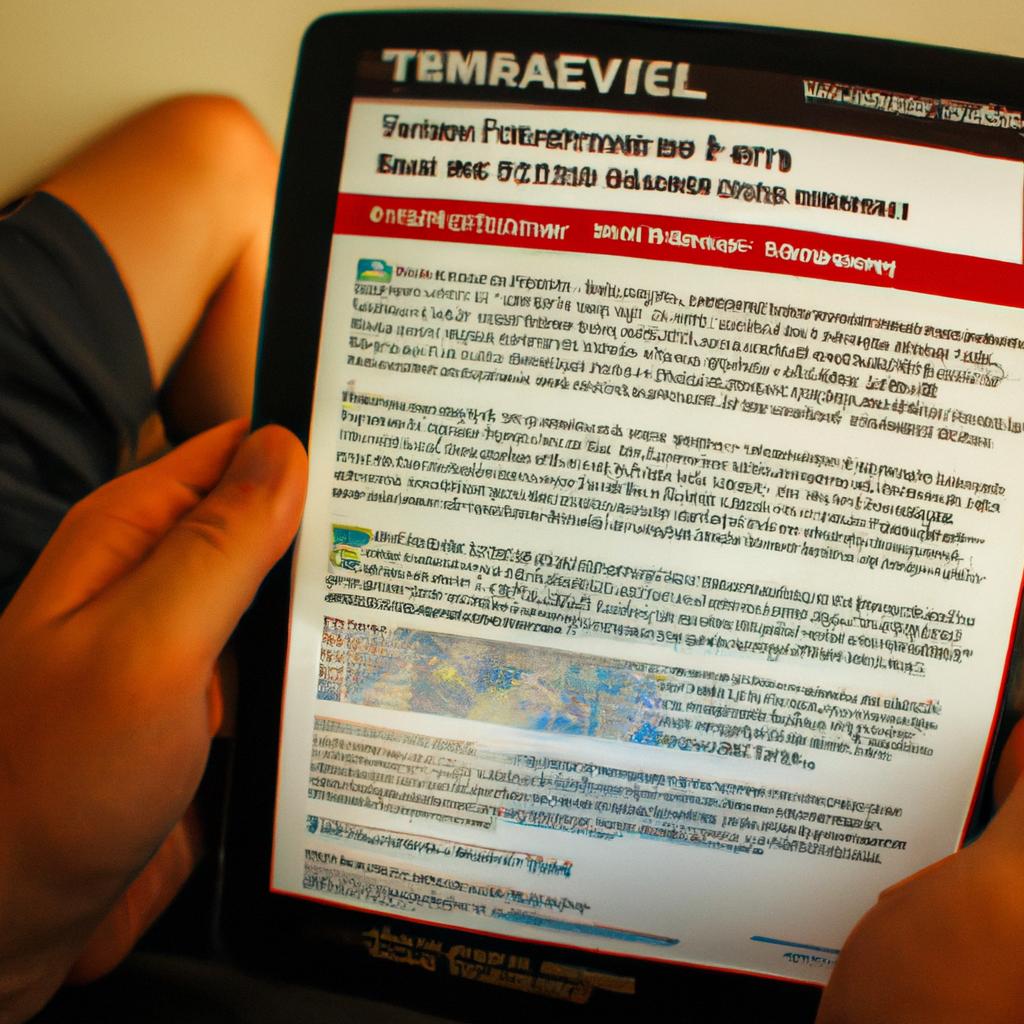Train travel has long been a popular mode of transportation for both domestic and international travelers. However, like any form of travel, train journeys are not without their challenges and potential risks. It is important for travelers to be aware of travel advisories related to train travel in order to ensure a safe and enjoyable journey.
One example that highlights the importance of being informed about train travel advisories is the case of a group of tourists who embarked on a cross-country train trip through a region known for its scenic landscapes. Unbeknownst to them, there were ongoing infrastructure repairs along certain sections of the railway line they planned to traverse. As a result, their journey was plagued with unexpected delays and detours, disrupting their itinerary and causing frustration among the passengers. This scenario underscores the significance of staying updated on travel advisories specific to train routes as it can help travelers make informed decisions regarding their chosen routes and avoid unnecessary inconveniences.
Understanding the potential dangers or disruptions associated with train travel requires knowledge of various factors such as regional weather conditions, political unrest, maintenance schedules, and other unforeseen circumstances. By keeping abreast of these travel advisories, individuals can better plan their trips accordingly and mitigate potential risks before embarking on their train journeys. In this article , we will explore some key sources of train travel advisories and how travelers can stay informed to ensure a safe and smooth journey.
One important source of train travel advisories is the national railway authority or company responsible for operating trains within a particular country. These authorities often provide regular updates on any disruptions or delays due to maintenance work, severe weather conditions, or other unforeseen events. Travelers can access this information through official websites, social media channels, mobile apps, or by contacting customer service representatives.
Another valuable resource for train travel advisories is the local transportation authority or agency in each region or city. They may issue warnings related to specific train lines or stations that are experiencing issues such as construction work, strikes, track closures, or security concerns. It is advisable for travelers to check these sources before planning their itinerary and during their trip to stay informed about potential disruptions.
Additionally, international organizations like the International Union of Railways (UIC) and the European Union Agency for Railways (ERA) provide general safety guidelines and recommendations for train travel across different countries. These organizations also publish reports on incidents and accidents involving trains worldwide. While not always specific to a certain route or location, these reports can help travelers gain an understanding of potential risks associated with train travel.
In addition to official sources, it can be helpful to consult online forums and travel communities where fellow travelers share their experiences and offer advice regarding train journeys in various destinations. These platforms allow individuals to exchange firsthand knowledge about recent incidents, delays, scams, or other issues they encountered during their trips. However, it is important to verify the credibility and reliability of information obtained from such sources before making any decisions based on them.
To stay updated on train travel advisories throughout their journey, travelers should consider subscribing to email alerts from relevant railway authorities or transportation agencies. This way, they will receive timely notifications about any changes in schedules or disruptions affecting their planned routes.
In conclusion, being aware of train travel advisories is essential for a safe and enjoyable journey. By staying informed about potential disruptions, travelers can make informed decisions, adjust their itineraries if necessary, and ensure a smooth and hassle-free train travel experience.
Types of train travel advisories
One example of a train travel advisory is severe weather conditions. Imagine you are planning to take a train trip from New York City to Chicago during the winter season. However, a major snowstorm hits the region, causing disruptions in transportation services. In this case, a travel advisory may be issued warning passengers about delays or cancellations due to the inclement weather.
Train travel advisories can also be related to infrastructure maintenance and repairs. For instance, if a railway track needs repair work or if there is scheduled maintenance on a specific route, an advisory might be issued informing passengers about potential changes in train schedules or alternate routes they need to consider.
In addition, security alerts form another category of train travel advisories. These alerts could pertain to threats such as terrorism or civil unrest that may compromise passenger safety while traveling by train. Authorities may issue warnings for specific regions or stations affected by these security concerns.
Finally, service disruptions caused by unforeseen circumstances like accidents, strikes, or technical malfunctions can result in train travel advisories being issued. Passengers may receive information regarding alternative transport options or additional delays they should expect.
- Delays and cancellations leading to missed connections
- Uncertainty and inconvenience when making plans
- Disruption of business meetings or other time-sensitive commitments
- Increased stress levels and frustration among passengers
Furthermore, here’s an illustrative table highlighting some common types of train travel advisories:
| Advisory Type | Example | Impact |
|---|---|---|
| Severe Weather | Snowstorm causes delays/cancellations | Missed connections |
| Infrastructure | Track repairs require schedule alterations | Uncertainty in planning |
| Security | Terrorism threat prompts heightened precautions | Heightened anxiety |
| Service Disruption | Technical malfunction leads to service disruption | Increased frustration and inconvenience |
Considering the different types of train travel advisories mentioned above, it becomes evident that staying informed is crucial for a smooth journey. Consequently, understanding how to stay updated on these advisories is essential. The subsequent section will provide helpful tips in this regard.
Tips for staying updated on train travel advisories
Types of train travel advisories can vary depending on the specific circumstances and risks associated with a particular journey. For instance, let’s consider a hypothetical situation where there is severe weather conditions affecting train services in a region. In such cases, the following types of advisories may be issued:
-
Delays or cancellations: Train operators often issue advisories about delays or cancellations due to various reasons like maintenance work, track repairs, or unforeseen incidents. Passengers are usually notified through official communication channels such as websites, mobile applications, or announcements at stations.
-
Service disruptions: Certain events or situations may disrupt train services temporarily. These could include strikes, protests, or emergencies that require immediate attention. Travel advisories regarding service disruptions provide information about alternative routes or transportation options available during these periods.
-
Safety and security alerts: Train companies prioritize passenger safety and security by providing timely warnings related to potential threats or hazards along certain routes. Such advisories might involve cautionary measures for passengers to follow in order to ensure their well-being during the journey.
-
Special considerations: Occasionally, there may be special considerations that affect train travel, such as sports events, festivals, or holidays leading to increased passenger volume and altered schedules. Advisories pertaining to these situations offer guidance on how travelers should plan their trips accordingly.
- Frustration due to unexpected delays
- Anxiety caused by service disruptions
- Relief when safety alerts help avoid potential dangers
- Appreciation for proactive communication during special events
Additionally, presenting this information in a table format can enhance clarity and engagement:
| Type of Advisory | Example Scenario |
|---|---|
| Delays/Cancellations | Track maintenance causing hour-long delays |
| Service Disruptions | Protest impacting train services in city center |
| Safety and Security | Alert regarding pickpocketing hotspots on a route |
| Special Considerations | Altered schedule due to annual music festival |
In summary, various types of advisories can significantly impact train travel experiences. Whether it’s delays, service disruptions, safety alerts, or special considerations, being aware of these advisories helps passengers plan accordingly and manage their journey effectively. Understanding the different types of advisories sets the stage for the subsequent section on how to interpret them and make informed decisions regarding train travel plans.
How to interpret train travel advisories
Now that we understand the importance of train travel advisories, let’s explore some tips to help you stay informed and up-to-date with the latest information.
Staying informed about train travel advisories is crucial in ensuring a smooth and safe journey. One effective way to do this is by signing up for alerts from reliable sources such as your local railway authority or transportation agency. For example, imagine you are planning a trip from New York City to Washington D.C. By subscribing to email notifications from Amtrak, you will receive real-time updates regarding any potential disruptions or delays along your intended route.
To further enhance your awareness, consider following official social media accounts of relevant organizations. Many railway companies use platforms like Twitter or Facebook to provide timely updates during unexpected incidents or adverse weather conditions. By doing so, you can quickly access critical information wherever you are and adjust your travel plans accordingly.
In addition to these methods, regularly checking online resources dedicated to train travel advisories can offer comprehensive insights into current conditions across various regions. Websites like Travel Advisories (www.traveladvisories.com) consolidate information from multiple sources, offering detailed reports on disruptions, maintenance schedules, and other important updates affecting train services worldwide.
- Ensure a seamless journey
- Stay updated on changes and disruptions
- Adapt travel plans according to advisory recommendations
- Enhance safety while traveling
| Source | Pros | Cons |
|---|---|---|
| Local Railway Authority | Reliable and accurate information | Limited scope of coverage |
| Social Media Accounts | Real-time updates accessible anywhere | Information overload may occur |
| Dedicated Websites | Comprehensive insights from multiple sources | Requires active searching for new information |
Understanding how to interpret train travel advisories is equally essential in making informed decisions during your journey. Let’s delve into the next section and explore this further: How to interpret train travel advisories.
[Write the subsequent section about “Common reasons for train travel advisories”]Common reasons for train travel advisories
Train travel advisories provide crucial information for passengers, enabling them to make informed decisions while planning their journeys. Understanding how to interpret these advisories is essential in ensuring a safe and hassle-free experience.
For instance, let’s consider the case of John, who was planning a trip from New York City to Washington D.C. He checked the train travel advisories before his departure and noticed a significant delay due to track maintenance on his route. Based on this information, he decided to reschedule his journey for the following day when the maintenance work would be completed. This example highlights the importance of interpreting train travel advisories accurately and taking appropriate action based on the provided information.
When reading train travel advisories, it is helpful to keep in mind several key points:
- Severity levels: Train travel advisories often include severity levels that indicate the impact of potential disruptions or hazards. These levels can range from minor delays or inconveniences to major service disruptions or safety concerns. Being aware of the severity level allows passengers to gauge the seriousness of the situation and determine if alternative arrangements need to be made.
- Affected areas: Advisories may specify particular sections of a railway network where disruptions are expected or specific routes with limited services. It is important for passengers to identify whether their intended journey falls within an affected area and plan accordingly.
- Alternative options: In some cases, train travel advisories offer suggestions for alternate transportation modes or rerouting options. Passengers should carefully consider these alternatives and assess which option best meets their needs in terms of time, cost, and convenience.
- Timeliness: Train travel advisories may change over time as conditions evolve or new information becomes available. Therefore, regularly checking for updates prior to and during your journey is recommended.
| Severity Level | Description |
|---|---|
| Minor | Minimal impact on travel; slight delays possible |
| Moderate | Some disruptions to service; moderate delays expected |
| Significant | Major disruptions or safety concerns; significant delays likely |
| Critical | Severe disruptions or hazardous conditions; avoid travel if possible |
Interpreting train travel advisories requires careful consideration and proactive decision-making. By familiarizing themselves with the severity levels, affected areas, alternative options, and the importance of staying updated, passengers can navigate through potential disruptions more effectively. In the subsequent section, we will discuss precautions to take during train travel advisories, ensuring a safe journey for all.
Transitioning into the next section about “Precautions to take during train travel advisories,” it is essential to remain vigilant and prepared in such situations.
Precautions to take during train travel advisories
Imagine you are a frequent train traveler planning a trip from New York City to Chicago. As you prepare for your journey, it is essential to be aware of common reasons for train travel advisories and the precautions that should be taken during such situations. By understanding these factors, you can better navigate potential disruptions and ensure a smoother travel experience.
Reasons for Train Travel Advisories:
Train travel advisories may arise due to various circumstances. One example is severe weather conditions along the planned route, such as heavy snowfall or hurricanes. These adverse weather events can cause delays, cancellations, or even temporary suspension of train services. For instance, during winter storms in the northeastern United States, Amtrak often issues advisories cautioning passengers about potential service disruptions.
In addition to inclement weather, other reasons for train travel advisories include infrastructure maintenance work or repairs on railway tracks and signaling systems. These necessary upkeep activities aim to maintain safety standards but may result in temporary schedule changes or rerouting of trains. It is crucial to stay informed about any planned maintenance that could affect your intended journey.
Precautions During Train Travel Advisories:
To mitigate inconvenience caused by train travel advisories, consider taking the following precautions:
- Stay updated: Regularly check official sources like Amtrak’s website or mobile app for real-time information regarding delays, cancellations, or alternative routes.
- Plan ahead: Allow extra time when scheduling your trip to accommodate unforeseen delays and have contingency plans if needed.
- Pack essentials: Carry necessary provisions like snacks, water bottles, medications (if applicable), entertainment options (books or electronic devices), and warm clothing in case of extended wait times.
- Communicate with authorities: If faced with unexpected disruptions while onboard a train, promptly seek assistance from train personnel who can provide guidance and updates.
Table: Emotional Impact
| Reason for Train Travel Advisory | Emotional Impact |
|---|---|
| Severe weather conditions | Frustration |
| Infrastructure maintenance | Inconvenience |
| Delays and cancellations | Anxiety |
| Uncertainty about alternative routes | Stress |
By understanding the common reasons behind train travel advisories and taking necessary precautions, you can navigate potential disruptions more effectively. Being proactive in staying informed, planning ahead, packing essentials, and seeking assistance when needed will help ensure a smoother journey.
Now let’s delve into the various resources available for checking train travel advisories to make sure you have all the information you need for a hassle-free journey.
Resources for checking train travel advisories
Precautions to take during train travel advisories
In the previous section, we discussed the importance of being aware of train travel advisories. Now, let’s delve into some precautions that can help ensure your safety and smooth journey when traveling during such advisories.
It is essential to plan ahead and stay informed about any upcoming travel advisories or disruptions on your intended train route. For instance, consider a hypothetical scenario where you are planning a trip from New York City to Washington D.C. During periods of severe weather conditions, it is crucial to check for any service interruptions or delays caused by heavy rain or snowstorms.
Here are some key precautions to keep in mind:
- Stay updated: Regularly monitor official sources like railway websites or mobile applications for real-time information about train schedules, cancellations, or alternative routes.
- Pack essentials: Make sure to carry necessary items such as extra food and water supplies, medication (if required), personal hygiene products, and an emergency kit containing first aid supplies.
- Keep devices charged: Ensure that your electronic devices like smartphones or tablets have sufficient battery life before embarking on your journey. This will allow you to access online resources or communicate with others if needed.
- Maintain situational awareness: Pay attention to announcements at train stations and be mindful of your surroundings while onboard. Familiarize yourself with emergency exits and evacuation procedures specific to each train car.
To further illustrate these precautions visually, here is a bullet point list highlighting their significance:
- Stay updated with real-time information
- Pack essential items for emergencies
- Keep electronic devices charged
- Maintain situational awareness
Additionally, refer to the following table which presents potential risks during train travel advisories along with corresponding precautionary measures:
| Risk | Precautionary Measure |
|---|---|
| Service interruptions | Check alternate transportation options |
| Extreme weather conditions | Dress appropriately and carry necessary supplies |
| Security threats or emergencies | Follow instructions from authorities |
| Medical emergencies on board | Know the location of emergency medical equipment |
In summary, taking precautions during train travel advisories is essential to ensure a safe and comfortable journey. By staying updated, packing essentials, keeping devices charged, and maintaining situational awareness, you can better navigate potential disruptions or challenges that may arise. Remember to check for any specific risks associated with your route and take appropriate measures accordingly. Stay informed, be prepared, and prioritize your safety at all times.
 Plains News
Plains News



